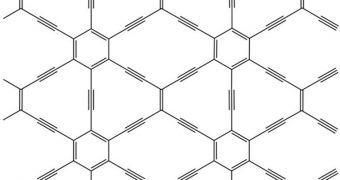Graphene, a form of carbon first synthesized in 2004, is currently proposed as a possible replacement for silicon in electronic devices. Many teams are working towards making this happen, but a group believes that the material called graphyne may be better suited for the task.
Graphyne is a carbon allotrope, just like graphene. The only differences appear in their structures, since they are both 2D, single-layer compounds. Graphene displays a perfectly hexagonal structure, where atoms are connected by bonds that are halfway between single and double.
This is the reason why the material is the strongest known, and also why it's nearly impossible to cause dents in it. For the purpose of this article, you need to remember the type of bonds and overall arrangement that graphene has.
Unlike its more famous counterpart, graphyne does not always boast a perfect, hexagonal arrangement. Its atoms are connected by double and triple bonds, meaning that it can take on a number of shapes.
The material has not yet been produced in quantities large enough to allow for direct studies, but computer simulations of how electrons would flow through it indicate that electrical current will only be able to move through it in a single direction.
This remarkable property could make graphyne preferable to both graphene and silicon for electronic applications. It could underlie the design of faster, more advanced transistors and other components.
The new study was co-authored by theoretical chemist Andreas Görling, who holds an appointment with the University of Erlangen-Nuremberg, in Germany. “If your material already conducts in one direction, you have a head start,” he explains.
One of the main advantages that graphyne has over graphene is that it can be created in a vast number of possible arrangements. Though these materials have been investigated since the 1980s, researchers still know comparatively very little about it.
The computer simulations were based on a research technique called density functional theory. These “calculations are quite reliable,” says Radboud University of Nijmegen condensed-matter theorist Mikhail Katsnelson.
“For instance, hydrogenated graphene [a type used to make graphene transistors] was first predicted by density-functional calculations and then was observed experimentally,” he concludes, quoted by Science Now.

 14 DAY TRIAL //
14 DAY TRIAL //